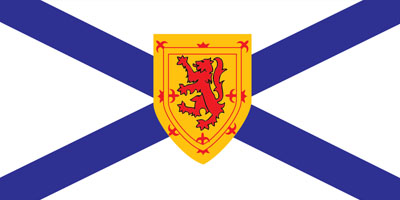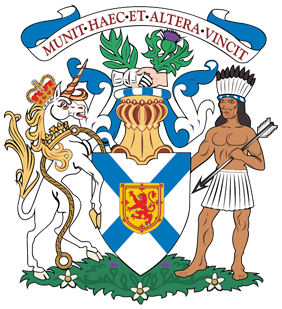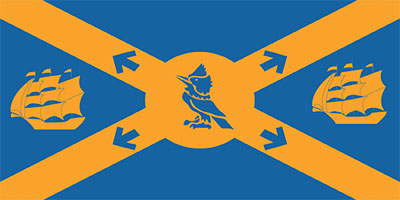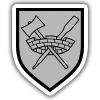Nova Scotia, Canada
Flag
The flag of Nova Scotia was the first flag in the overseas Commonwealth to be authorized by royal charter. It is derived from the ancient arms granted in 1625. The flag features the province's shield extended in a rectangular shape.

Other Provincial Symbols
- Floral Emblem: The Mayflower
- Tartan: The Nova Scotia Tartan
- Tree: Red Spruce
- Bird: Osprey
- Animal: Nova Scotia Duck Tolling Retriever Dog
- Fruit: Wild Blueberry
- Gemstone: Agate
- Mineral: Stilbite
- Acadian Flag
Coat of Arms
Nova Scotia's coat of arms, granted in 1625, is the oldest of any province or territory. The shield features the Cross of St. Andrew. To differentiate between Scotland and Nova Scotia, the colours of the cross are reversed: blue on white. At the centre of the Nova Scotia shield is the shield of the Royal Arms of Scotland, containing a royal lion within a double red border on a field of yellow or gold.

The crest above the shield features two hands, one armed and the other bare, supporting a laurel and a thistle. One interpretation of this has the armed hand and the thistle representing the vow of the King of the Scots to protect his subjects, and the bare hand and the laurel sprig representing the conquest of hardships to be met in Nova Scotia. The laurel sprig is a symbol of peace, triumph and conquest.
The shield is supported by a crowned unicorn, part of Scotland's royal coat of arms, and an Aboriginal man, representing the province's native Indian population.
A royal helmet - facing forward - rests on the shield. A unique feature of the Nova Scotia coat of arms is that the motto is placed above the arms, a common practice in Scotland.
Nova Scotia is the only province to have had a coat of arms annulled. When the province joined Confederation, it was assigned a new coat of arms, as were the other new provinces. Unlike the other provinces, however, Nova Scotia had already been granted one. After the First World War, there was a movement to restore the province's original arms. This change received royal approval in 1929.

Origin of the Name
Nova Scotia was named by Sir William Alexander, who received a grant to all the land between New England and Newfoundland from King James VI of Scotland (King James I of England) in 1621. The official charter was in Latin and the name "New Scotland" retained its Latin form - Nova Scotia.

History
The Mi'kmaq of the Algonquian linguistic group inhabited Nova Scotia long before the arrival of European explorers and were among the first of Canada's Aboriginal peoples to see Europeans. The Mi'kmaq allied themselves with the French throughout early Canadian history, helping them adjust to the land and fight the British.
All of Nova Scotia, as well as parts of Quebec, New Brunswick and Maine, was originally known as Acadia and mainly settled by the French. Fur trader Pierre de Monts established the first successful agricultural settlement in Canada at Port-Royal (now Annapolis Royal, Nova Scotia) in 1605. For the next century, the British and the French fought over the area. Control passed back and forth until 1713, when all of Acadia, except Île Royale (now Cape Breton Island), was ceded to the British under the Treaty of Utrecht.
After the Seven Years War, Nova Scotia included Saint John's Island (as Prince Edward Island was then known), Cape Breton Island and the area now known as New Brunswick. In 1769, Saint John's Island separated from Nova Scotia. In 1784, after a great influx of loyalist refugees from the United States, Nova Scotia was partitioned to create the colonies of New Brunswick and Cape Breton Island. However, Cape Breton again became part of Nova Scotia in 1820.

Civic Flags
Halifax, Nova Scotia


















































